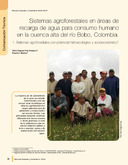| dc.contributor.author | Vela Enríquez, María E. | |
| dc.contributor.author | Jiménez, Francisco | |
| dc.date.accessioned | 2019-08-28T17:16:54Z | |
| dc.date.available | 2019-08-28T17:16:54Z | |
| dc.date.issued | 2010-03 | |
| dc.identifier.issn | e-ISSN: 1659-1216 | ISSN |
| dc.identifier.uri | https://repositorio.catie.ac.cr/handle/11554/9150 | |
| dc.description.abstract | En la cuenca alta del río Bobo, Colombia, se
practica la agricultura intensiva -principalmente el
cultivo de papa- en zonas prioritarias para la recarga de las fuentes de agua para consumo humano.
Aunque el cultivo es muy rentable, afecta la calidad
y regulación del agua; por ello se busca introducir
algunos sistemas agroforestales que podrían contribuir a mejorar la calidad y disponibilidad de agua.
Con la participación activa de los agricultores y
propietarios de las tierras y la aplicación de diferentes herramientas metodológicas, se identificaron,
caracterizaron y priorizaron los principales sistemas
agroforestales que, según la experiencia local,
contribuyen a la recarga hídrica. Posteriormente,
se determinaron los costos de establecimiento,
mantenimiento y rentabilidad de los mismos y se
calculó el monto de compensación que se debiera
ofrecer a los productores o propietarios de la tierra
por adoptar el sistema agroforestal papa-cercas
vivas de aliso, que fue el SAF con mayor potencial
hidroecológico y socioeconómico para la zona de
estudio. | |
| dc.description.abstract | Intensive agriculture is practiced in the
upper basin of Bobo River, where potato is the
main cash crop in areas where water recharge for
human consumption is of first importance. Even
though potato is a very profitable crop, it affects
the quality of water and the hydrological regulation;
that’s the reason why the introduction of some
agroforestry systems could help to improve both
quality and availability of water. With the active
participation of farmers and landowners, and the
use of different methodological tools, major agro forestry systems contributing to water recharge
were identified, characterized and prioritized. The
establishment and maintenance costs as well as
profitability of those agroforestry systems were also
determined. Finally, the amount of money to be
offered to producers or landowners as compensa tion for adopting the agroforestry system potato alder hedgerows was also calculated. This was the
agroforestry system with the greatest hydroecologi cal and socioeconomic potential in the study area. | |
| dc.language.iso | es | es_ES |
| dc.publisher | CATIE, Turrialba (Costa Rica) | es_ES |
| dc.relation.ispartof | Recursos Naturales y Ambiente Número 59-60 (Marzo-Agosto 2010), páginas 68-75 | |
| dc.rights | info:eu-repo/semantics/openAccess | |
| dc.subject | ALNUS GLUTINOSA | |
| dc.subject | AGUA POTABLE | |
| dc.subject | RECURSOS HIDRICOS | |
| dc.subject | ABASTECIMIENTO DE AGUA | |
| dc.subject | CONSERVACION DE AGUAS | |
| dc.subject | CUENCAS HIDROGRAFICAS | |
| dc.subject | RENTABILIDAD | |
| dc.subject | AGROFORESTERIA | |
| dc.subject | COLOMBIA | |
| dc.title | Sistemas agroforestales en áreas de recarga de agua para consumo humano en la cuenca alta del Río Bobo, Colombia. 1. Sistemas agroforestales con potencial hidroecológico y socioeconómico | es_ES |
| dc.title.alternative | Agroforestry systems in water recharge
areas for human consumption in Bobo
River, Colombia. 1. Agroforestry systems
with hydroecological and socioeconomic
potential | |
| dc.type | Artículo | es_ES |


